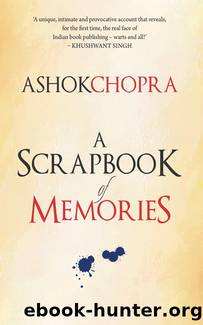A Scrapbook of Memories by Ashok Chopra

Author:Ashok Chopra
Language: eng
Format: epub
Publisher: HarperCollins
Published: 2015-01-15T00:00:00+00:00
Amongst the pictorial records of the club, the earliest photograph is one dated 1876 showing a group from the play Cast by one Robertson. The women are dressed in black stuffed gowns with bustles and the men wear six-bottom coats with shapeless trousers, and all look very earnest. Another point noticeable is the facial disguise that was taken very seriously. An interesting picture pertains to the year 1897 that shows a geisha pulling the pigtail of Lord Baden Powell, the chief scout.
A word about the extravagance of âThe Old Ladyâ would perhaps not be out of place. In those days money flowed in and out of its coffers with little check. In 1894 the season opened with a credit balance of Rs 3,660 but by the end turned into a debit balance of Rs 1,600. During this season no less than Rs 7,000 was spent on dresses alone, of which one play, Burlesque, absorbed Rs 1,500 and the band had cost Rs 2,100.
However, the funniest year in many ways was 1896. It saw the largest number of comedies staged at the Gaiety Theatre, receipts for which totalled Rs 50,000 and the balance in hand on 31 December amounted to ten annas (about sixty paise today). Though, in 1899, receipts totalled Rs 44,000, of which the boxes alone realized Rs 10,653, the season closed with a debit balance of Rs 1,100. The fact becomes comprehensive when we learn that The Yeoman of the Guard (or The Merryman and His Maid), a savoy opera, took Rs 50,000 and lost Rs 4,400. Felix Mendelssohnâs The Wedding March (1842) could peal out to a tune of expenses covering the income.
Tales about âThe Old Ladyâ being taken out of the red by her fond lovers are numerous. In 1891, the ADC owed two yearsâ rent and lacked the wherewithal to pay. Lord William Beresford, military secretary to Viceroy Lord Lansdowne, came to the rescue and personally shouldered responsibility for the debt. In 1898, Lieutenant General Sir Gerald de Courcy Morton, adjutant-general in India advanced Rs 2,000 to âavoid having to pay interest on overdraftâ.10
Strict discipline was enforced at the club in those days. An example: for holding the disciplinary tradition was the decision taken ânot to employ the 5th D.G. Band owing to the very unsatisfactory behaviour of the band masterâ.11 Even the fair sex was not immune. Two ladies, who absented themselves from the chorus of Solanthe on the last night, were placed in the blacklist, never to be asked to perform again.
The year 1936 was marked by the production of the most successful play ever staged by the club â Mary Rose by Major W. H. Crichton and a splendid cast that included the viceroyâs (Lord Victor Hopeâs) daughter, Anne. The last play, before the British left India in 1947 was Noel Cowardâs Harvey, directed by Edward Everard.
One man who, according to records, stuck loyally to the Simla ADC was B. N. Brown. He was for forty-three years â till his death in
Download
This site does not store any files on its server. We only index and link to content provided by other sites. Please contact the content providers to delete copyright contents if any and email us, we'll remove relevant links or contents immediately.
Asking the Right Questions: A Guide to Critical Thinking by M. Neil Browne & Stuart M. Keeley(5572)
Autoboyography by Christina Lauren(5154)
Eat That Frog! by Brian Tracy(4378)
Dialogue by Robert McKee(4271)
Sticky Fingers by Joe Hagan(4060)
Journeys Out of the Body by Robert Monroe(3537)
Annapurna by Maurice Herzog(3395)
Full Circle by Michael Palin(3346)
Schaum's Quick Guide to Writing Great Short Stories by Margaret Lucke(3278)
Elements of Style 2017 by Richard De A'Morelli(3278)
The Art of Dramatic Writing: Its Basis in the Creative Interpretation of Human Motives by Egri Lajos(2944)
Why I Write by George Orwell(2849)
The Diviners by Libba Bray(2840)
In Patagonia by Bruce Chatwin(2829)
The Mental Game of Writing: How to Overcome Obstacles, Stay Creative and Productive, and Free Your Mind for Success by James Scott Bell(2816)
The Fight by Norman Mailer(2794)
Atlas Obscura by Joshua Foer(2758)
Venice by Jan Morris(2495)
The Elements of Style by William Strunk and E. B. White(2413)
